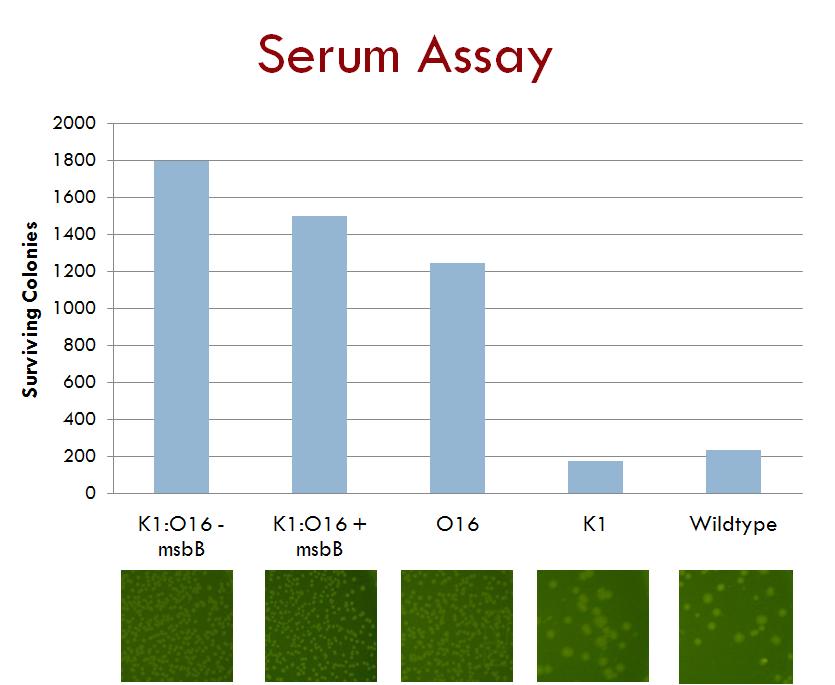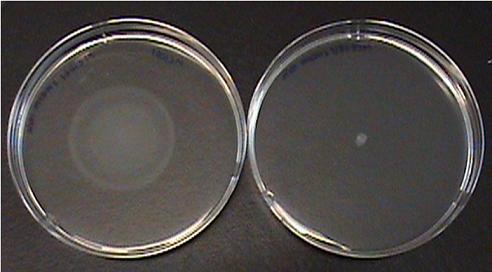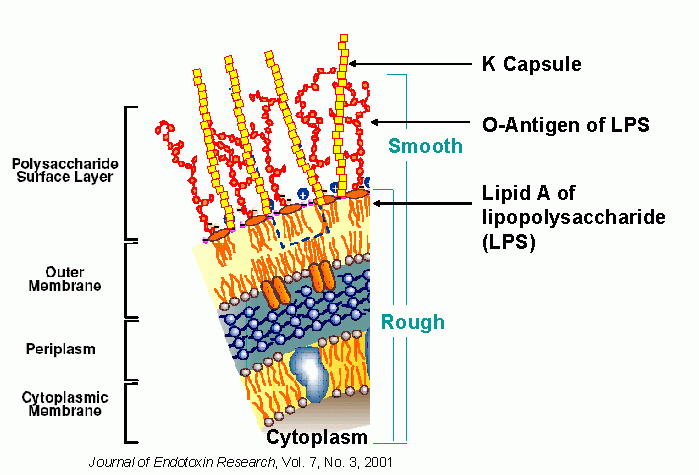BerkiGEM2007Present4
From 2007.igem.org
<< Back to UC Berkeley iGEM 2007 • Next: The Controller >>
The Chassis
There are several core issues associated with introducing E. coli into the bloodstream of human beings or other animals. First is the issue of sepsis. E. coli possesses a species called lipid X, or endotoxin, in its outer membrane which causes the release of TNFalpha in humans. This is an essential process of the innate immune system, but high doses of lipid X can be lethal. Bactoblood must have some ability to avoid this series of events. Similarly, there are a variety of additional features in E. coli that can elicit strong adaptive immune responses including the pili and flagella. From the bacterium's perspective, the interaction with the bloodstream is no more desirable. The complement system, another core component of the innate immune response, can kill bacteria directly. Additionally, phagocytic cells including macrophages and neutrophils, can engulf and kill E. coli. Fortunately for our purposes, there are a variety of modifications we can make to circumvent these problems.
The E. coli outer surface
To understand these modifications, we must first understand what features are present in E. coli strain MC1061, our starting point for Bactoblood. Like most strains of E. coli used in the lab, MC1061 comes from the MG1655 lineage and is a "rough" strain. Unlike other "smooth" strains, MC1061 lacks surface-displayed capsular polysaccharides known as K capsules and O antigens. It retains the general 2-membrane architecture present in gram-negative bacteria. In between these membranes is the periplasmic space which is composed of a gel-like carbohydrate-rich polymer called peptidoglycan. The inner membrane is composed of a lipid bilayer and a variety of proteins. The outer membrane similarly is a lipid bilayer, and the lipid component of it is called lipopolysaccharide, or LPS. The structure of LPS at it's core is a 6 fatty acid lipid called lipid X. When O antigen polymer chains are present, they are covalently attached to the outer leaf of LPS. K capsules are similarly embedded in the outer leaf of the outer membrane, but they are not directly attached to LPS. Other components of the outer membrane include a structural protein, LPP, and a variety of other proteins. This outer surface is the critical region of the bacterium for understanding how it interacts physically with the outside world. When the bloodstream "looks" at E. coli, what it "sees" is the outer membrane because everything else is stuck inside. Modifications such as O antigens and K capsules therefore have dramatic effects on the bacterium's interactions with the outside world.
Capsular Polysaccharides

The carbohydrates embedded in the outer membrane are extremely diverse within the E. coli species. Both K capsules and O antiens are linear carbohydrates polymer, but at least 150 chemically-distinct O antigens exist in one E. coli strain or another. Similarly, at least 100 chemically-distinct K capsules have been described. Almost all pathogenic strains of E. coli have some sort of capsular polysaccharide and are referred to as "smooth" strains. The rough vs. smooth distinction refers to a visibly discernible quality of their colonies. The particular choice of carbohydrate present in a bacterium is essential to its ability to survive in its living environment. For pathogenic and commensal bacteria, specific O or K carbohydrates are appropriate for distinct areas of the body (blood stream, urinary tract, intestines) and also for distinct animal types (birds, pigs, humans, cows, etc.). Over 90% of human cases of E. coli bacteremia (the clinical word for having bacteria in the bloodstream) are caused by strains that have a specific type of K capsule called K1. K1 is a long linear polymer of sialic acid that extends about half the diameter of the bacterium beyond its surface. Because polysialic acid is a frequent coating on mammalian cells, the human immune system does not recognize K1 as foreign. Bacteria with a K1 capsule are therefore resistant to both innate and adaptive immune responses. Proper display of a K1 capsule requires the concomitant expression of any of several O antigens. For our studies, we have chosen O16. Genetically, the K1 capsule requires 14 genes encoded within a 20kb cassette. The O16 antigen requires 11 genes encoded within a 12kb cassette. Together, these surface modifications allow the bacterium to avoid detection by the immune system and should extend the serum half-life of Bactoblood to several hours rather than the less-than-5 minutes observed with rough strains. Both of these gene clusters have been installed into the genome of MC1061 in the course of preparing our chassis strain, MC828U.
Lipid X and its variants
The lipid X component of the LPS in E. coli contains 6 acyl chains. Mammalian blood contains a protein called LBP that scavenges this molecule from both live and lysed bacteria and transfers it to toll-like receptor 4 present on mammalian cells. These events initiate a signal transduction cascade resulting in the release of a protein called TNFalpha. The inflammatory response to these events at low doses helps your body fight off bacterial infections. At higher doses, it can result in organ failure and even death. The lipid X moiety present in a variety of other bacteria do not initiate this cascade of events. Similarly, a pentaacylated variant of the E. coli lipid X is 1000x less agonistic of this response. Our bacteria synthesize this pentaacylated variant due to the deletion of the gene responsible for attaching the sixth acyl chain, msbB.
Additional cell-surface epitopes
Essentially any component on the surface of the bacteria has the potential to elicit either innate or adaptive immune responses. Of those present on MC1061's surface, type I pili and flagella are known to elicit such responses. Each of these features is encoded within multi-gene operons encoding protein assemblies that extend out from the bacteral surface. Type I pili allow bacteria to adhere to the surface of mammalian cells. Flagella are the "propellers" that allow the bacteria to swim during chemotaxis. Bactoblood does not require either of these activities, so these genes were deleted in the chassis strain.
Growth control by iron restriction
A critical challenge in the development of Bactoblood is the ability to safely inject a large quantity of bacteria into the bloodstream. It is essential that these bacteria do not grow for a safe administration. We have adopted a two-tier strategy for eliminating the possibility of growth. First, we make our bacteria unable to grow in the bloodstream due to their inability to acquire a specific nutrient, iron. Secondly, we introduce a genetic kill switch device that destroys the bacterium's DNA once it has produced all the necessary biochemical components needed to carry oxygen. E. coli can acquire iron by either high-affinity or low-affinity iron transport. When they grow in LB media, they use low-affinity transport which involves specific membrane-embedded transporters that can pump in free iron ions. In animal body fluids, the concentration of these ions is less than 10-15 molar. The iron is sequestered in small molecule chelators such as heme or proteins like transferrin and ferritin. Acquiring iron in such an environment requires more elaborate processes involving secreted chelators that can grab the iron from these proteins. These processes, collectively referred to as high-affinity iron transport, all require the function of tonB. By deleting tonB in our chassis organism, we obtain a strain that retains its ability to grow normally in LB media but is unable to grow in mammalian body fluids.
Characterization of the chassis, MC828U
The genotype of our chassis organism is:
MC828U delta(araA-leu)7697 araD139 delta(codB-lac)=deltalac74 galK16 galE15 mcrA0 relA1 rpsL150 spoT1 mcrB9999 hsdR2 O16(deltawbbL) K1(deltaneuS) deltamsbB deltafim deltatonB deltaflhCD upp::(Ptet-wbbL-neuS)
To illustrate the function of our chassis, here we show the function of 2 critical features of chassis: its ability to survive in serum and loss of chemotaxis due to the deletion of flagella.
The serum assay shows the chassis' ability to survive in serum due to its K1:O16 additions and msbB deletion.

In a swarming assay done to demonstrate the effect of flagella deletion, the wildtype MC1061 cells on the left plate were able to swim out much farther than those of the MC828U chassis, shown on the right plate.

